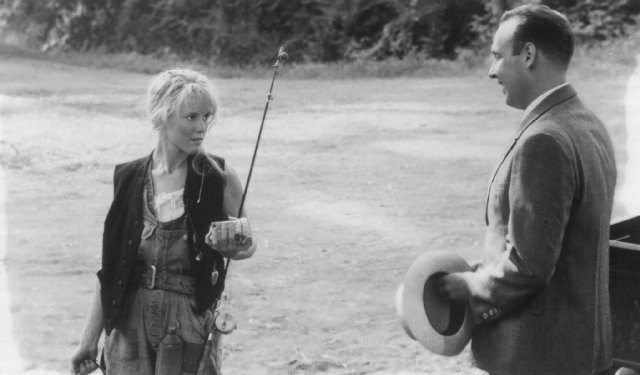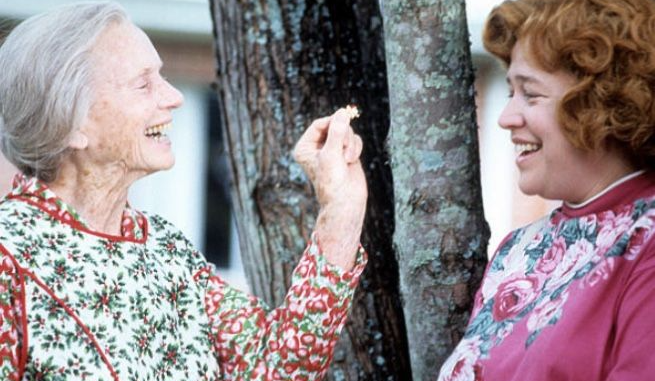
For more than three decades, “Fried Green Tomatoes” has endured as one of the South’s favorite films thanks to the touching story, larger-than-life characters and authentic depiction of the region thanks to the beloved source material.
Based on Birmingham native Fannie Flagg’s 1987 novel “Fried Green Tomatoes at the Whistle Stop Cafe,” the film was written by Flagg and Carol Sobieski and stars Kathy Bates, Jessica Tandy, Mary Stuart Masterson, Mary-Louise Parker and Cicely Tyson.
It tells the story of a housewife who, unhappy with her life, befriends an elderly lady in an Alabama nursing home and is enthralled by the tales she tells of people she used to know.
The film holds a 75 percent rating on Rotten Tomatoes. The Critics Consensus reads, “Fried Green Tomatoes’ tearjerking drama is undeniably manipulative, but in the hands of a skilled cast that includes Jessica Tandy and Kathy Bates, it’s also powerfully effective.”
Against a budget of $11 million, it earned just shy of $120 million at the box office.
To celebrate more than 30 years, we listened to the DVD commentary with director Jon Avnet (”Up Close & Personal,” “Righteous Kill”) to learn more behind-the-scenes stories and tidbits about the production, the connections to Alabama and much more.
While Fannie Flagg based the Whistle Stop restaurant on the real-life Irondale Café in Irondale, Ala., they filmed much of the movie including the café scenes in the small Georgia town of Juliette.
Avnet said the movie was completely inspired by Flagg’s book, and his first thought/image for the film when he was reading the book was imagining a “ghost train” speeding through the town of Whistle Stop. It became the central image of the movie for him, when Kathy Bates arrives in the town at the beginning, as she hears something nobody else hears. He said it reminded him of scouting locations early in his career when he would pass through “ghost towns” without stopping to wonder or learn what had been there before.
One thing that appealed to Kathy Bates about making the movie was a chance to work with Jessica Tandy, but Avnet said the “Misery” actress also had a “great burning desire” to destroy a Volkswagen because her boyfriend/future husband had one.
Young Idgie was played by Alabama native Nancy Atchison, who appears during he first 17 minutes of the movie. Now married to her high school sweetheart, Bradley Hendrix, and living in Homewood, with their teenage son, Noah, “the light of our lives,” Nancy Hendrix (originally from Montgomery) works as the director of development at the Birmingham Museum of Art. “She was a trouper,” Avnet said about the young actress.
To create a connection between young, middle and older Idgie, Avnet had Atchison and Tandy wear contact lenses so their blue eyes would be brown.
Avnet said the that that flies off of Ruth’s head was “one pain in the butt.” He said if you ever try to do what they made that hat do, “good luck.” They tied a fishing line to it, but he wanted it to roll on its brim, which was a very difficult effect to create. It took four or five hours just a shoot a few seconds of hat close-ups.
Tandy had just finished chemotherapy before shooting the movie. Avnet said she had no hair and wore a wig. “She had an appreciation of life that was enormous. It comes out in her performance. It came out in being with her.”
Born in South Carolina, actress Mary-Louise Parker “had a beautiful Southern accent from the first time she came in,” Avnet said. “Although typical to her nature and to many actors, she insisted on having a dialogue coach to ruin it. But luckily, didn’t prevail.”
Avnet said a nearby river where they rehearsed scenes was full of water moccasins. Once, when he and the actors went into the river, he saw one that was in “attack position,” and he lunged out of the water, “proving white men can jump.” They had to find another location for rehearsal and filming. “You didn’t have them in Brooklyn growing up.”

“The bee sequence was probably the real magic of the movie,” Avnet said about a pivotal scene involving reaching into a beehive. He said a stunt person decided not to do the stunt that day of filming. The director discussed the scene with actress Mary Stuart Masterson and introduced her to the on-set bee expert before she decided to perform the stunt herself, sticking her hand inside a live beehive. “This is not CGI. That’s a couple of hundred thousand bees around a hive, and a real honeycomb.” Avnet said honeybees are relatively safe and won’t sting unless provoked.
Avnet said Mary-Louise Parker insisted she was not athletic, but when it was time to shoot the baseball scene, she rose to the occasion. “You can’t train somebody to be as bad as Mary-Louise is,” he said, but Avnet praised actors like Parker for performing under pressure when the cameras started rolling.
During a night shoot in the water, the cast and crew relocated after the water moccasin attack. But regardless of the change of scenery, nature found a way to intrude. Parker was attacked by a leech around 2 a.m. The actress let her director know about it, too. “She had mild profanity aimed at my for the things I made her do.” Avnet said location scouts searched all over Georgia for a lake that had no snakes, and when they found it, leeches took their place.
Avnet said he found eating fried green tomatoes and other Southern cuisine to be “a treat.” He only wished he’d had the forethought to know how popular the titular food would become upon the release of the movie, reminding him of another project of his. “I’d done another movie, ‘Risky Business,’ and I was not smart enough to buy the concession on Ray-Bans when Tom Cruise was wearing them,” he said. “And I probably should have bought all the green tomatoes in America and made a fortune on the number of fried green tomatoes that were made when this movie came out.”
When Jessica Tandy reveals her new hairdo — a purple perm — a perplexed Kathy Bates doesn’t know what to say. Tandy asks Bates if she likes it, and instead of answering, Bates says, “Who did it for you, darlin’?” Avnet said, “That’s a truly Southern answer.”
One of the things that initially attracted Avnet to Flagg’s book was the way it depicted racial relationships, in terms that were not stereotypical. He said he spent a lot of time with author Alex Haley before his death (the last time Avnet saw him was at the premiere of “Fried Green Tomatoes” in Atlanta), and said, “When he would describe the world to me, it was just different than the way we’d seen in the media. And I was very interested to try and portray it and to try and do justice to what Alex would tell me in the stories, images and feeling. Fannie was from that same world and had a similar feeling.”
They shot the film in about 10-12 weeks, which Avnet said is a shorter timeframe than usual for a Hollywood production. He said he first edited a shorter cut of the movie and kept adding footage to make it longer based on the reaction of test audiences.
The food fight scene in the Whistle Stop kitchen was achieved in one take. Avnet called it the closest thing to a love scene in the film. Masterson and Parker improvised much of it.
Cicely Tyson wanted to portray her character Sipsey without talking. Avnet said he had lunch with her in New York City ahead of production where he persuaded her to talk in the role. Still, he said Tyson was so gifted, she could stay silent and remain “unbelievably expressive” on screen.
In his research, Avnet found that the Ku Klux Klan was at its height in terms of membership during the 1920s. He points out that there was Klan outside the South in places like Long Island and Connecticut. “A lot of the reason it was successful was it was like a Ponzi scheme, and people could make money by selling memberships. It wasn’t just the ideology, which definitely appealed to some, but as always, the mighty dollar was part of that.”
After filming completed, the sets used for the town’s main street were renovated into a tourist district in Juliette, Ga., including a fully operational “Whistle Stop Cafe,” filled with memorabilia related to the movie.
The film earned Oscar nominations for best supporting actress (Tandy) and best adapted screenplay, scoring noms for Fannie Flagg and co-writer Carol Sobieski. Thy lost to Mercedes Ruehl (“The Fisher King”) and “The Silence of the Lambs,” respectively.
When she saw the movie, Jessica Tandy contacted Avnet to compliment him and the performances of the actors. And she asked him why he never told her during filming that Ninny and Idgie were the same person. He insisted he did tell her, and she simply responded, “Oh.”
The film is more ambiguous about Idgie and Ruth’s romantic relationship than Flagg’s novel, leading to some criticism for glossing over the depiction of a gay romance. But the film would win the GLAAD Media Award for Outstanding Film — Wide Release.
